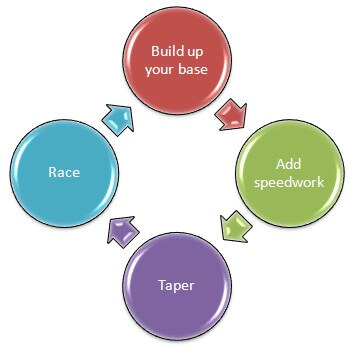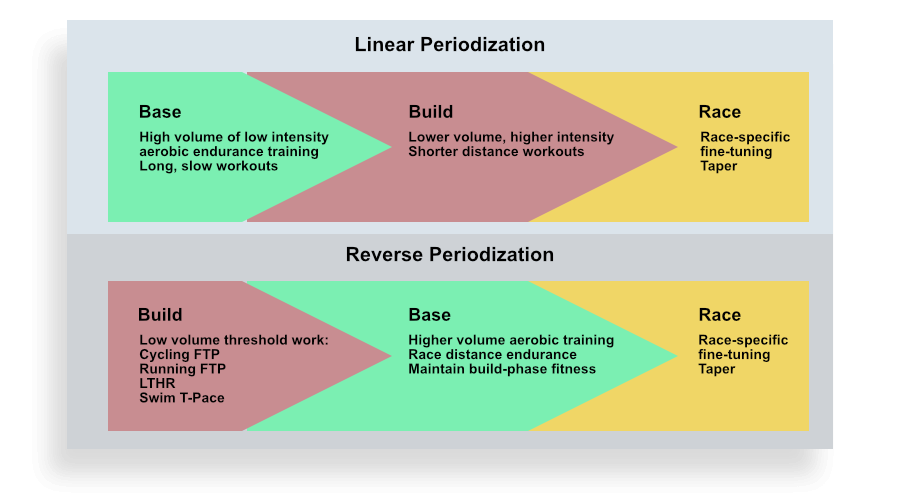Periodized Training 101: Easy Guide for Runners & Other Athletes

Periodization training is done to capitalize on your training in a way that helps you to reach long-range goals.
Designed strategically to promote long-term improvements, the athlete has training of different intensities over the course of a training cycle.
In addition to varying intensity, the volume or frequency of workouts can be changed.
Why Do Athletes Use Periodization Training?
The most common reason for using periodization training is to prevent overtraining. The biggest danger of overtraining is injury.
However, other problems that occur include burnout and overall fatigue. Coaches often use periodization programs to be certain that athletes do not fall into any of these pitfalls.
Coaches not only use their knowledge of training in a particular sport or overall fitness, but they also take the athlete’s individual strengths, level of fitness, and goals into consideration. This allows the coach to create an ebb and flow of training that has the athlete peaking at the best time.
Another reason for periodization training is that most of us make the mistake of doing most of our workouts at a pretty steady pace. In other words, we find a comfort zone, and we stick with it. There is also the problem that many athletes find a pace they can dial into without too much difficulty, and they do so without variation.
When athletes switch to periodization training models, the number one thing that people comment on is that suddenly, their harder workouts get much harder. Still, the easy run days get way easier. This is intentional!
Lastly, periodization training can prevent you from hitting a training plateau.
What Is a Periodized Training Program?
In a periodization training regiment, the athlete intentionally manipulates the variables of their training, such as duration, rate of perceived exertion, and more. All of which helps the athlete optimize performance, prevent overtraining or injury, and progress performance in a systematic fashion.

Mixing up the intensity or volume of a workout can get the athlete to peak when you most want to. If you have heard of a taper, this is a concept you are at least vaguely familiar with.
How Do You Periodize Your Training?
First of all, you need to recognize that even the most elite of athletes cannot be in top physical condition at all times. This is why periodized training is so important. Athletes cannot always be to their “peak,” so it is necessary to change the training intensity to get the most out of it.
If you are looking to periodize your training, there are three main types of cycles. You can train in macrocycles, which are often looking at the big picture, such as a year of training.
There is also a mesocycle. A mesocycle is a 4-6 week cycle within the macrocycle.
Lastly is the microcycle. The microcycle is typically one week and exists within the mesocycle.
What Are the Phases of Periodization?
- Preparatory Phase: This phase consists of general preparation and specific preparation.
- Competitive Phase: The competition phase can be made up of pre-competition, which is warm-up races or competitions, and primary competitions. For example, a marathon training plan could have you do a couple of warm-up races leading up to the full marathon (the goal race).
- Transition Phase: Transition is a time of regeneration and recuperation. It allows the athlete to recuperate and recover both physically and psychologically. During this phase, the athlete is not in the competitive season.
Examples of Periodization Training
If you are looking for periodization training program examples, you have come to the right place.
The three most common types are linear, non-linear (or undulating periodization), and block periodization.
What Is Linear Training?
LInear training is the kind practiced by most casual runners. In this type of training, your major training stimuli are segregated within the training process. That means that aerobic training, strength training, resistance training, weightlifting, powerlifting, speed work, etc., are all separated out in the training process.

The most commonly known form of the linear style has training broken up into four phases: hypertrophy, strength, power, and transition phases.
Hypertrophy workouts are where you do more sets and reps at a lower intensity. This description is often used in weight training (see below to compare hypertrophy to strength training).
Non-Linear Training
In non-linear periodization or undulating training, you are continually changing the straining stimuli within each microcycle. Athletes might do workouts focusing on strength and explosive speed at the same time. While some people are huge proponents of linear training, others feel non-linear is the way to go.
This style of training has different variables changing frequently. This means that your training load, exercises, work intensity, activity volume, etc., can often be shifting.
You might train strength one day, then work on explosive power the next.
Block Periodization
This type of program design breaks training sessions into blocks of approximately 2-4 weeks.
Each block has three stages: accumulation, transmutation, and realization.
The accumulation block is done at 50-75% intensity; transmutation is 75-90% intensity, and realization is at 90% intensity or more.
These smaller specific blocks can allow for an athlete to keep at peak performance longer than some other plans.
What is Hypertrophy vs. Strength Training?
While in hypertrophy, you are doing more sets and reps at a low intensity, you are increasing the intensity during strength training, which means more weight.
In addition to adding weight, you are engaging in fewer repetitions and have more rest between sets to allow for recovery.
Tips from a Running Coach
Evan Woods, RRCA certified coach from “Just Another Running Coach,” has this to say about periodized training:
“The beauty of periodized plans is that they’re completely scalable to the individual. We can have a rookie marathoner with two kids at home, an experienced pro who can feast on over 100 miles per week, and a walk/runner who wants to improve their time over last year… even though each of their plans will be tailored to meet their individual needs and goals, they can all follow the same general structure, perform similar workouts and by the end, they’ll have experienced the same highs and lows as each other, even if their race day looks vastly different.
In a way, a good periodized plan is like the North Star, continuously guiding you, no matter who you are or what your goals are, along the road to success. If you ever feel lost, it’s always there to help you get back on the right track.”
Should You Try It?
In my experience, many recreational runners do their training in silos. In other words, you are looking at each piece and component of your training as single entities.
The beauty of periodized training is that it pushes you to maximize your potential with a holistic approach to your training.
Also, this training allows you to cycle your training so that your body does not get beat up by overuse. The cycles help keep your body “fresh” while still continuing to grow toward that ultimate goal.
If you still have questions, Coach Wood is a contributing member of our RunnerClick Pro community. Give it a look!
Sources
- , Periodization Training: A Beginner’s Guide, Health Website
Latest Articles
 Is Running on a Treadmill Easier Than Running Outside?Runners have their own preferences, whether it is treadmill running, running outside on the road, or exploring trails. So...
Is Running on a Treadmill Easier Than Running Outside?Runners have their own preferences, whether it is treadmill running, running outside on the road, or exploring trails. So... Is It OK to Use Trail Running Shoes on the Road?While trail running shoes can be used on roads, especially in situations where a runner encounters mixed terrains or pref...
Is It OK to Use Trail Running Shoes on the Road?While trail running shoes can be used on roads, especially in situations where a runner encounters mixed terrains or pref... How to Fix Sore Quads After Running?Rest, ice, gentle stretching, and over-the-counter pain relievers can help soothe sore quads after running. Also, ensure ...
How to Fix Sore Quads After Running?Rest, ice, gentle stretching, and over-the-counter pain relievers can help soothe sore quads after running. Also, ensure ... 10 Fruits With The Most Electrolytes to Replace Sports DrinksThese fruits are high in electrolytes such as potassium, magnesium, and calcium, essential for hydration, muscle function...
10 Fruits With The Most Electrolytes to Replace Sports DrinksThese fruits are high in electrolytes such as potassium, magnesium, and calcium, essential for hydration, muscle function...

